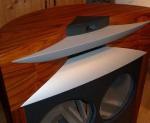I use Intertechnik Audyn Cap Plus for the HF section of my 4343 and I really like them.
I can get discount on them. PM me if you interested in a price list.
This is the review from an link in an earlier post.
Technical Specifications:These low loss capacitors have been developed for extreme impulse/power handling. An important design/constructional feature is the power handling of the connection between the foils (electrodes) and the end. The Audyn Cap Plus has a vastly improved system of connecting the electrodes to the end leads. Audyn Cap Plus also utilizes an internal series connection system whereby layers of metal foil are combined with a one-side metallized "blind" layer. As a result of the double metallization performance is greatly enhanced. Dielectric: Polypropylene Winding: Induction free: 2 windings series connected Layers: Vacuum metallized Body: Aluminium, Synthetic material (plastic). Rather highly priced cap.
Sound: The Audyn Cap Plus is a true high-end capacitor! They sound a bit hard at first and have a sort of midrange haze because they take a while to burn-in. But after a few days of normal use they deliver a very spatial sound with lots of depth that only gets better as time passes. Perfect reproduction of the finest musical nuances. Furthermore, the effect is not only achieved with very expensive high-end components. It delivers a significant enhancement in more price-conscious configurations, making it a very worthwhile upgrade even though it is rather expensive. Clarity, depth, detail and openness from top to bottom! When I first switched over to these I thought, “this is it!” even though they were fresh from the shelf. They sound a little more mid-range forward compared to the equally good Mundorf Supreme Cap. Although they are expensive, the degree of improvement is a value compared to the cost of high-end cables and interconnects.




 Reply With Quote
Reply With Quote





